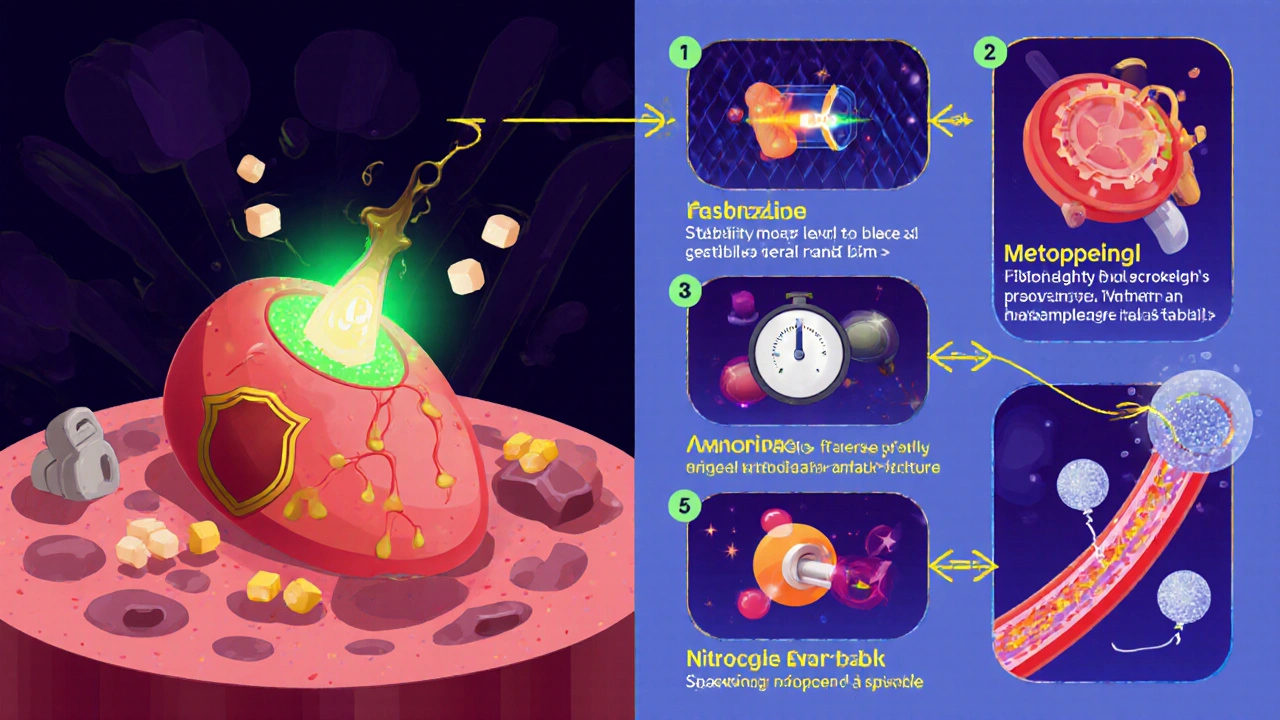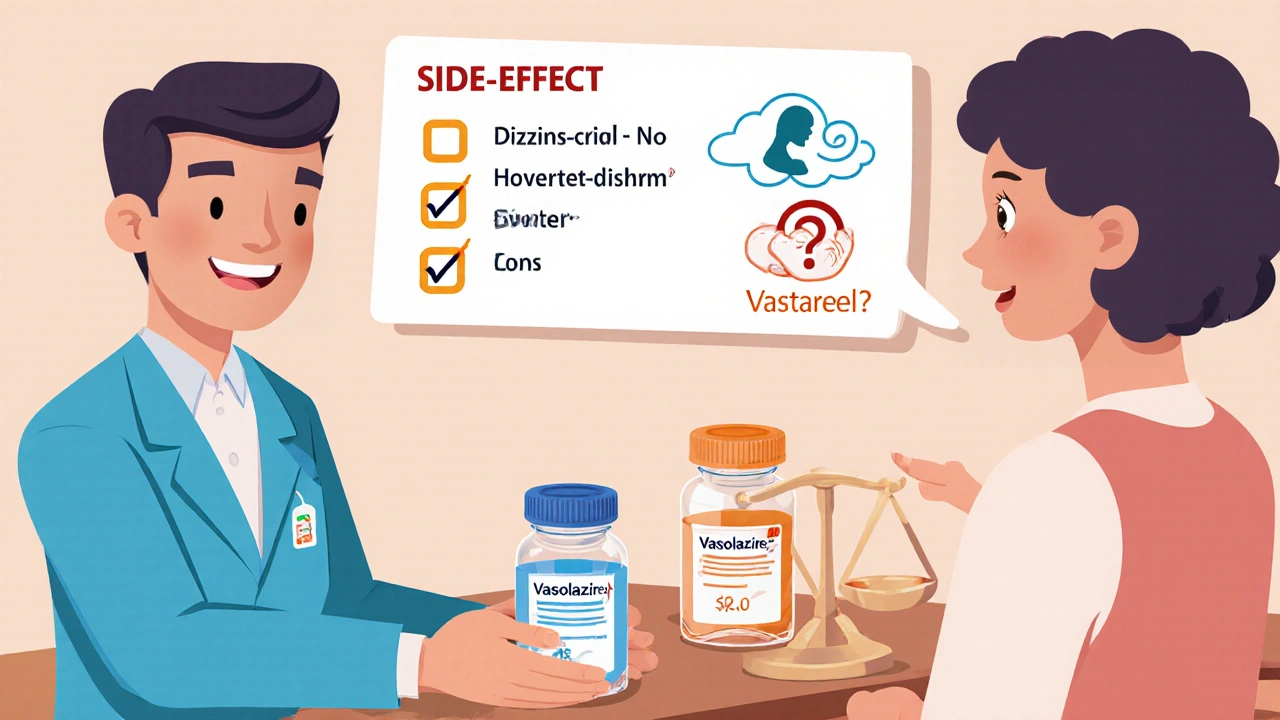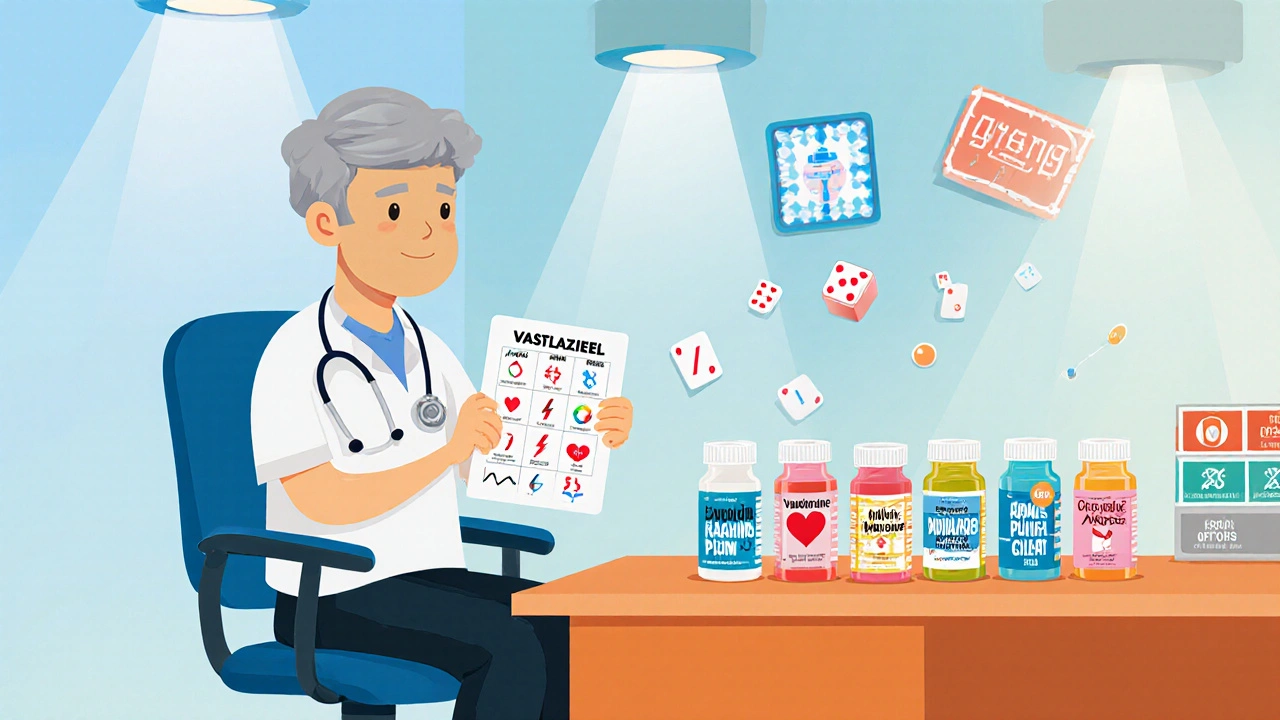When you’re dealing with chronic chest pain or reduced blood flow to the heart, picking the right medication can feel like a high‑stakes game. Vastarel (Trimetazidine Dihydrochloride) is one of the options on the table, but it’s not the only player. Below, we break down how Vastarel measures up against the most common alternatives, so you can see which drug fits your health profile, lifestyle, and doctor’s advice.
Key Takeaways
- Vastarel works by improving how heart cells use energy, not by changing heart rate or blood pressure.
- Ranolazine, Ivabradine, beta‑blockers, calcium‑channel blockers, and nitrates each target different mechanisms.
- Side‑effect profiles differ: Vastarel is well‑tolerated, while some alternatives can cause dizziness, low blood pressure, or headaches.
- Choosing the right drug depends on your exact diagnosis, other health conditions, and how your body reacts.
- Always discuss drug interactions and dosing with a healthcare professional before switching.
What is Vastarel (Trimetazidine Dihydrochloride)?
Vastarel is a brand name for Trimetazidine Dihydrochloride, an anti‑ischemic agent that enhances cellular metabolism in the heart muscle. It belongs to the class of metabolic modulators. Instead of lowering heart rate or dilating vessels, it shifts heart cell energy production from fatty‑acid oxidation to glucose oxidation, which needs less oxygen. The result is less pain during an angina episode and better exercise tolerance.
Why Compare? The Jobs‑to‑Be‑Done
People searching for a comparison usually have a few concrete goals:
- Understand how Vastarel’s mechanism differs from other anti‑anginal drugs.
- Identify which alternative has the best side‑effect profile for them.
- Know dosing schedules and how each drug interacts with common comorbidities (e.g., diabetes, hypertension).
- Find out if a cheaper generic version or lifestyle change could be a viable substitute.
Each section below tackles one of those jobs.
Mechanism‑by‑Mechanism: How the Drugs Work
- Vastarel (Trimetazidine): Shifts myocardial metabolism to glucose, reducing oxygen demand without affecting heart rate or blood pressure.
- Ranolazine: Inhibits the late sodium current, stabilizing the cardiac cell membrane and improving blood flow.
- Ivabradine: Selectively slows the funny (If) current in the sino‑atrial node, lowering heart rate while keeping contractility intact.
- Metoprolol (beta‑blocker): Blocks beta‑adrenergic receptors, reducing heart rate, contractility, and oxygen consumption.
- Amlodipine (calcium‑channel blocker): Dilates arteries by inhibiting calcium influx, improving blood supply to the heart.
- Nitroglycerin (nitrate): Releases nitric oxide, causing venous dilation and reduced cardiac preload.
Notice that Vastarel’s approach is metabolic, while the others focus on heart rate, vascular tone, or electrical stability. That fundamental difference drives the side‑effect and contraindication profile for each drug.

Comparison Table: Dosage, Benefits, and Drawbacks
| Drug | Class | Typical Dose | Key Mechanism | Pros | Cons |
|---|---|---|---|---|---|
| Vastarel (Trimetazidine) | Metabolic modulator | 35mg×2‑3timesdaily | Shifts myocardial metabolism to glucose | Well‑tolerated, no heart‑rate change | Limited use in severe heart failure, not a first‑line for acute angina |
| Ranolazine | Late sodium current inhibitor | 500mg×2timesdaily (max1000mg) | Stabilizes cardiac cell membrane | Effective for chronic angina, can be added to beta‑blockers | Dizziness, QT prolongation, contraindicated with CYP3A4 inhibitors |
| Ivabradine | If‑current blocker | 5-7.5mg×2timesdaily | Reduces heart rate without affecting contractility | Useful when beta‑blockers are not tolerated | Visual disturbances (phosphenes), bradycardia, not for acute HF |
| Metoprolol | Beta‑blocker | 50-100mgoncedaily (or split) | Blocks β1‑adrenergic receptors | Reduces mortality in CAD, easy to combine | Fatigue, bronchospasm in asthma, can worsen depression |
| Amlodipine | Calcium‑channel blocker | 5-10mgoncedaily | Vasodilation via calcium influx inhibition | Improves blood flow, helps hypertension simultaneously | Peripheral edema, gum hyperplasia, not ideal in severe LV dysfunction |
| Nitroglycerin | Nitrate | 0.3-0.6mg sublingual PRN; 5-20mg oral daily | NO‑mediated venous dilation | Fast relief of acute angina attacks | Headache, tolerance development, contraindicated with PDE5 inhibitors |
When to Pick Vastarel Over the Rest
If you’ve tried a beta‑blocker or calcium‑channel blocker and still feel limited exercise capacity, Vastarel can be added without risking bradycardia or hypotension. It’s especially handy for patients who can’t tolerate a lower heart rate-think of the elderly with baseline sinus bradycardia or athletes who need to keep a steady pulse.
Clinical guidelines (European Society of Cardiology 2023) list Trimetazidine as a ClassIIb recommendation for stable angina when first‑line drugs fail or cause side‑effects. Real‑world data from a 2022 multicenter registry showed a 15% reduction in weekly angina episodes after three months of adding Trimetazidine to standard therapy.
Alternatives: Who Might Benefit More?
Ranolazine shines when you need additional symptom control after beta‑blockers and nitrates. It’s also useful for patients with diabetes because it does not affect glucose metabolism. However, watch out for drug interactions-especially with strong CYP3A4 inhibitors like ketoconazole.
Ivabradine is a go‑to for chronic stable angina if you can’t use beta‑blockers (e.g., due to asthma). It specifically targets heart rate, so you’ll see a clear drop in beats per minute without the fatigue tied to beta‑blockers.
Beta‑blockers such as Metoprolol remain first‑line for post‑MI patients because they lower mortality, not just symptoms. If you have a history of myocardial infarction, the survival benefit often outweighs modest side‑effects.
Calcium‑channel blockers (Amlodipine) are best when you need both angina relief and blood‑pressure control. They’re also preferred in patients with vasospastic (Prinzmetal) angina, where coronary artery spasm is the main issue.
Nitrates stay the fastest option for an on‑the‑spot angina attack. They’re not ideal for long‑term control because tolerance can develop within a week of continuous use.
Cost and Accessibility
In many countries, generic Trimetazidine costs about $0.10‑$0.15 per 35mg tablet, making it one of the cheaper metabolic modulators. Ranolazine’s brand form (Ranexa) can be pricey-up to $5 per 500mg tablet-though a generic is emerging. Ivabradine (Corlanor) sits in the mid‑range ($2‑$3 per tablet). Beta‑blockers and calcium‑channel blockers are usually the most affordable, often covered by insurance.
Online pharmacies often list Vastarel alongside its generic name, making it easy to compare price. If you’re on a tight budget, ask your doctor if the generic Trimetazidine is available in your market.

Safety Tips and Common Pitfalls
- Never combine nitrates with phosphodiesterase‑5 inhibitors (Viagra, Cialis) - risk of severe hypotension.
- Check kidney function before starting Ranolazine; dose may need adjustment.
- Ivabradine can cause visual “phosphenes.” If they persist, stop the drug.
- Beta‑blockers can mask hypoglycemia symptoms in diabetics - monitor blood sugar closely.
- Trimetazidine is contraindicated in patients with Parkinson’s disease or movement disorders.
How to Talk to Your Doctor
- Bring a list of all current meds, including over‑the‑counter supplements.
- Explain the frequency and triggers of your chest pain (e.g., during exercise, at rest).
- Ask specifically about metabolic modulators like Trimetazidine and whether they fit your profile.
- Discuss side‑effect concerns - e.g., “I’m worried about dizziness; which drug minimizes that?”
- Request a follow‑up plan: how long to try the new drug, what labs to repeat, and when to reassess symptoms.
Bottom Line
Vastarel offers a unique metabolic route to relieve angina, making it a solid add‑on when heart‑rate‑lowering drugs aren’t ideal. However, it isn’t a one‑size‑fits‑all solution. Ranolazine, Ivabradine, beta‑blockers, calcium‑channel blockers, and nitrates each have specific strengths that may line up better with your health status, lifestyle, and budget.
The smartest move is a personalized conversation with your cardiologist, armed with the comparison points above. That way you can weigh mechanisms, side‑effects, and costs before committing to a regimen.
Frequently Asked Questions
Can I take Vastarel with my usual beta‑blocker?
Yes. Trimetazidine does not affect heart rate or blood pressure, so it can be combined safely with beta‑blockers. Your doctor may adjust doses based on overall symptom control.
Is there a generic version of Vastarel?
The generic name is simply Trimetazidine Dihydrochloride. It’s widely available in most markets and typically costs less than the branded product.
What are the main side‑effects of Trimetazidine?
Most users experience mild gastrointestinal upset or headache. Rarely, it can worsen movement disorders like Parkinson’s disease, so it’s avoided in those patients.
How quickly does Vastarel start working?
Improvement in exercise tolerance can be seen within 2-4 weeks of consistent dosing, though full benefits may take up to three months.
Can I replace my nitrate spray with Vastarel?
No. Nitrates provide rapid relief during an acute attack, while Trimetazidine works on chronic symptom reduction. They serve different purposes and are often used together.
Is Trimetazidine safe for people with diabetes?
Yes. Because it shifts heart metabolism without affecting glucose pathways, it’s considered safe for diabetic patients. Still, monitor blood sugar as any medication can have indirect effects.
What should I do if I miss a dose of Vastarel?
Take the missed tablet as soon as you remember, unless it’s close to the next scheduled dose. In that case, skip the missed one and continue with your regular timing. Don’t double‑dose.


Roberta Makaravage
Look, the heart is not just a pump, it's a metaphor for our moral duty to treat our bodies with respect 🧭. Trimetazidine's metabolic approach aligns with the ethical principle of minimizing harm, unlike drugs that force the heart to race. If you ignore the biochemical nuance, you're essentially endorsing reckless pharmacology. The literature clearly shows that when patients prioritize metabolic modulators, they're exercising autonomy responsibly. So, choose wisely, and remember that every dosage is a moral decision 🌟.
Lauren Sproule
hey folks i think this breakdown is super helpful lol i especially liked the part about cost and how cheap generic trimetazidine can be. if anyone's on a budget just ask your doc about the generic name it’s usually way cheaper. hope this helps you all feel a bit more confident!
CHIRAG AGARWAL
another drug list? whatever, these meds all smell the same. guess you’ll just pick one and hope for the best.
Rebecca Mitchell
i dont see why anyone would even consider trt when beta blockers do the job just fine
Katie Henry
Esteemed readers, it is commendable that you are proactively researching anti‑ischemic therapies. Your dedication to informed decision‑making exemplifies the highest standards of patient stewardship. May your discussions with healthcare professionals be fruitful, and may your chosen regimen enhance both longevity and quality of life.
Joanna Mensch
while the article paints a neutral picture, one must consider that pharmaceutical giants quietly influence guideline committees. the push for newer, pricier agents often serves corporate profit rather than patient welfare. stay skeptical of the narratives presented and seek independent sources.
RJ Samuel
i've gotta say, all this hype around metabolic modulators feels like a flashy circus act. sure, shifting to glucose sounds neat, but give me a good old beta‑blocker any day – it's tried, true, and doesn't need a PhD to understand.
Chris Beck
Brits think they know best??? USA knows how to fight heart disease!!
James Falcone
America first.
Valerie Vanderghote
Honestly, when I read these tables I feel a wave of exhaustion wash over me, as if the very act of comparing pills is a betrayal of my inner calm. The way the author stacks dosage numbers feels like a relentless march of corporate metrics that ignore the human soul. Each bullet point about side‑effects is a tiny dagger aimed at my patience, reminding me that my heart is already battling enough. I can’t help but think about the countless patients whose lives are reduced to a spreadsheet of numbers, their stories lost in a sea of pharmacology. The mention of cost, while useful, also fuels a gnawing anxiety about who gets access and who doesn’t, as if the market decides who deserves relief. Even the regulatory references sound like a distant echo of authority that seldom hears the murmurs of the bedside. I am haunted by the image of an elderly man taking a pill at midnight, wondering if the manufacturer cares at all. The claim that Trimetazidine shifts metabolism feels almost mystical, yet it is presented with the same cold clinical tone as any nitrate. Does anyone truly understand what it feels like to have a heart that “shifts” under stress? I wish the article had a paragraph on the lived experience, the breathlessness during a garden walk, the fear of a missed beat. Instead we get tables, which while informative, strip away the messy, beautiful reality of living with angina. My mind drifts to the pharmacies where the drugs sit behind glass, waiting for a prescription that may never come. I imagine the pharmacy clerk’s indifferent stare as they hand over a box of tablets, a transaction that feels more like a pact with fate. The safety tips listed are useful, sure, but they also remind me how fragile our bodies are in a world that sells us solutions like candy. If only there were a space for patients to voice their doubts without being labeled non‑compliant. I find myself yearning for a community where we can share stories, not just data. In the end, I hope the writer remembers that behind every generic name lies a person hoping for a steadier heartbeat and a quieter mind.
Michael Dalrymple
Dear fellow reader, your eloquent articulation of the patient experience underscores the profound interplay between clinical evidence and personal narrative. Such reflective discourse reminds us that medicine, at its core, is a humanistic endeavor. May your insights guide clinicians toward more empathetic care, and may patients find solace in both data and story.
Nickolas Mark Ewald
Thanks for the thorough comparison, it helped clarify the options.